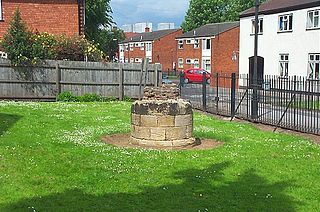Robert Winchelsey was an English Catholic theologian and Archbishop of Canterbury. He studied at the universities of Paris and Oxford, and later taught at both. Influenced by Thomas Aquinas, he was a scholastic theologian.

John de Stratford was Archbishop of Canterbury, Bishop of Winchester, Treasurer and Chancellor of England.

Roger Northburgh was a cleric, administrator and politician who was Bishop of Coventry and Lichfield from 1321 until his death. His was a stormy career as he was inevitably involved in many of the conflicts of his time: military, dynastic and ecclesiastical.

Castle Ashby is a village and civil parish in the West Northamptonshire unitary authority area of Northamptonshire, England. At the 2011 Census, the population of the parish was 111.

William III de Cantilupe was the 3rd feudal baron of Eaton Bray in Bedfordshire, and jure uxoris was feudal baron of Totnes in Devon and Lord of Abergavenny. His chief residences were at Calne in Wiltshire and Aston Cantlow, in Warwickshire, until he inherited Abergavenny Castle and the other estates of that lordship.

Thorpe Langton is a village and civil parish in the Harborough district of Leicestershire, about four miles north of Market Harborough. The parish had a population of 171 according to the 2001 census. Ten years later, in the 2011 census, the population had grown to 200. Thorpe Langton is the home of the Baker's Arms pub and St. Leonard's church, but is otherwise solely residential.
William Booth or Bothe was Bishop of Coventry and Lichfield from 1447 before becoming Archbishop of York in 1452 until his death in 1464.

Thorpe Waterville is a village in the English county of Northamptonshire. It is combined with Achurch to form the ecclesiastical parish of 'Thorpe Achurch'; in turn this is added to another combined parish, Lilford-cum-Wigsthorpe, to form the grouped parish council of Lilford-cum-Wigsthorpe and Thorpe Achurch. This is part of North Northamptonshire.

Lenton Priory was a Cluniac monastic house in Nottinghamshire, founded by William Peverel circa 1102-8. The priory was granted a large endowment of property in Nottinghamshire and Derbyshire by its founder, which became the cause of violent disagreement following its seizure by the crown and its reassignment to Lichfield Cathedral. The priory was home mostly to French monks until the late 14th century when the priory was freed from the control of its foreign mother-house. From the 13th-century the priory struggled financially and was noted for "its poverty and indebtedness". The priory was dissolved as part of King Henry VIII's Dissolution of the Monasteries.
Events from the 1320s in England.
Langton is a surname. Notable persons with that surname include:
Alexander de Stavenby was a medieval Bishop of Coventry and Lichfield.
Robert de Stretton was Bishop of Coventry and Lichfield following the death of Roger Northburgh in 1358. A client of Edward, the Black Prince, he became a "notorious figure" because it was alleged that he was illiterate, although this is now largely discounted as unlikely, as he was a relatively efficient administrator.

Thorpe Waterville Castle was a medieval fortified manor house near Thorpe Waterville, Northamptonshire, England.
Nicholas Seagrave, lord of Stowe in Northamptonshire, was Marshal of England from 1308 to 1316. He was the second son of Nicholas of Seagrave, first Baron Seagrave and a leading supporter of Simon de Montfort in his struggle with King Henry III.
The Canterbury and York Society is a British text publication society founded in 1904. It publishes scholarly editions of English medieval (pre-Reformation) ecclesiastical records, notably episcopal registers.
Stephen Devereux of Bodenham and Burghope was a member of a prominent knightly family in Herefordshire during the reigns of Edward I, Edward II and Edward III. An important retainer of the de Bohun Earls of Hereford, he gave rise to the Devereux Earls of Essex and Viscounts of Hereford.

The House of Stratford is a British aristocratic family, originating in Stratford-on-Avon between the eleventh and thirteenth centuries. The family has produced multiple titles, including Earl of Aldborough, Viscount Amiens, Baron Baltinglass, Viscount Stratford de Redcliffe and the Dugdale Baronets. The Viscount Powerscourt and Baron Wrottesley both claim descent from this House. Historic seats have included Farmcote Manor and Stratford Park in Gloucester, Merevale Hall in Warwickshire, Baltinglass Castle, Belan and Aldborough House in Ireland, and Stratford House in London, amongst many others. The house was at its most powerful in the fourteenth, sixteenth, and eighteenth centuries.












